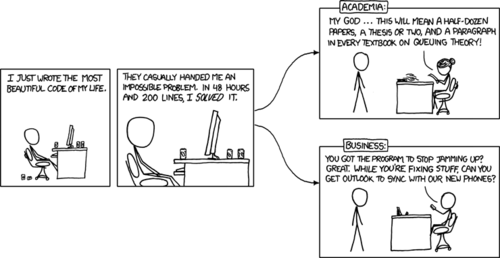
A man at his desk, surrounded by empty cans of Mountain Dew™, reflects on the magnitude of a particular block of code he has just written. The code he has written is concise, beautiful and solves a seemingly impossible task - it is the perfect code.
After these first two panels, the comic strip becomes a flow-chart. We are presented with two options for who gave this particular problem to the man, along with their respective responses.
Academia: the intelligent female professor excitedly proclaims that this particular piece of code will yield them publishable academic papers, multiple theses and acclaim amongst their peers. This is a common response to anything done by students within a professor’s group. Whatever it is, no matter how trivial or specific, try and make a paper out of it and get funding. This is an effect of the constant cycle of publication and funding that forms a majority of the post-graduate academic ecosystem. I would draw a diagram of this cycle, but that is not my medium.
Business: in this case, an ignorant male boss responds to the man’s code without care or congratulations. He merely comments that the man has fixed a technical problem but more exist, such as the classic IT bug: outlook syncing. These two problems, while wildly different to the engineer, are seen as equivalents to the businessman.
The statement being made is this: in academia, solved problems and new algorithms themselves are important, whereas in business they are seen as things to be used.
Note: this is not new information to anyone.
